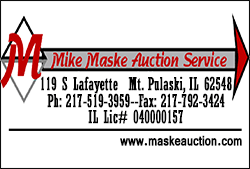|
 The estimated harvest
numbers are compiled by the National Agricultural Statistics Service
(NASS) which have been gathered directly from farmers who file a
report. Compiled information is then published by the United States
Department of Agriculture (USDA). The estimated harvest
numbers are compiled by the National Agricultural Statistics Service
(NASS) which have been gathered directly from farmers who file a
report. Compiled information is then published by the United States
Department of Agriculture (USDA).
In the Spring corn and soybean reports are estimated with the 2019
yields announced on Feb 20, 2020.
Illinois' estimated average for soybeans was 54.0 bushels per acre
in 2019.
While each of the counties adjacent Logan County 2019 estimated
soybean yields were higher than the state average, the figures all
reflected lower yields than in the year 2018:

Why are the NASS 'Yield Estimates' important and what impacts
might no numbers have for area farmers and the Ag industry?
According to the USDA, the NASS reports help farmers decide
production plans, "such as how much corn to plant, how many cattle
to raise, and when to sell."

More broadly speaking the USDA states, "The statistical information
on acreage, production, stocks, prices, and income compiled by the
NASS, including yield estimates, "would be hard to overestimate the
importance to agriculture. Producers, farm organizations,
agribusinesses, lawmakers, and government agencies all rely heavily
on the information produced by NASS."
The various data is "indispensable for planning and administering
related Federal and State programs in such areas as consumer
protection, conservation and environmental quality, trade,
education, and recreation."
The information ensures "a
flow of goods and services among agriculture's producing,
processing, and marketing sectors. Reliable, timely, and detailed
crop and livestock statistics help to maintain a stable economic
climate and minimize the uncertainties and risks associated with the
production, marketing, and distribution of commodities."

"NASS estimates and forecasts are greatly relied upon by the
transportation sector, warehouse and storage companies, banks and
other lending institutions, commodity traders, and food processors.
Those in agribusiness who provide farmers with seeds, equipment,
chemicals, and other goods and services study the reports when
planning their marketing strategies.
"Analysts transform the statistics into projections of coming
trends, interpretations of the trends' economic implications, and
evaluations of alternative courses of action for producers,
agribusinesses, and policy makers. These analyses multiply the
usefulness of NASS statistics."
[to top of second column] |
 Reasons the 2019 NASS
report may not have included Logan County estimated soybean yields
fall into two categories.
1) Planted but did not harvest
- Took Prevented Plant
Claim for Any Crop, Planted Soybeans as
Cover Crop for Hay
- Planted, but crop
failed
- Planted and expected
to be harvested for hay/forage
- Planted, failed, then
planted to other crop
2) Did not plant
- Intended to be
planted, didn't plant, took prevented plant claim
- Intended to be
planted, didn't plant, and didn't take
- prevented plant
claim
While the exact reason(s) for
the lack of estimated yield results is not stated, it is easy to
take an educated guess at what happened to soybeans in Logan County
in 2019. The central Illinois 2019 crop year was late due to cold,
late due to wet conditions. Winter cold set the soil frost layer
deep, late season cold kept soils a little too cool for good seed
germination. The warming days that finally brought the soil temps up
also brought repetitive heavy rains that continued to July 4th.
Saturated and ponded soils kept farmers from getting into the field
at the risk of getting stuck, causing soil compaction and potential
seed rot. For producers that got into the fields late, low areas
were often not successful at producing plants, leaving little or no
time to replant and get a harvest.
Using the average of six reporting adjacent counties, 61.6 bu/acre,
DeWitt was also no report for soybeans, and seeing end of season
fields with scattered loses, the Logan County average may be
guesstimated at something less 61.6 bu/acre soybeans in 2019.
|